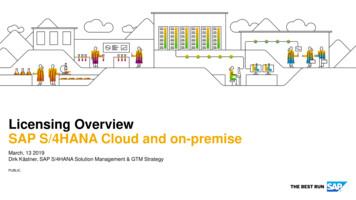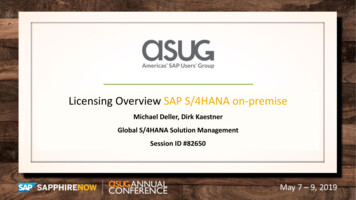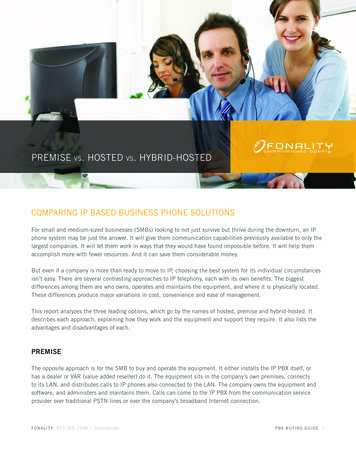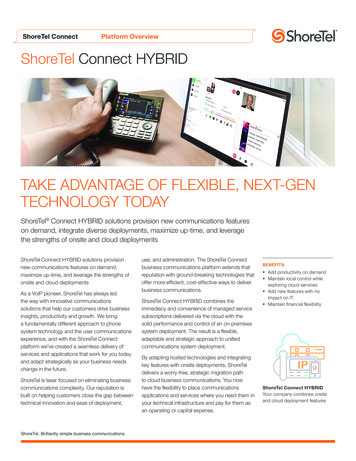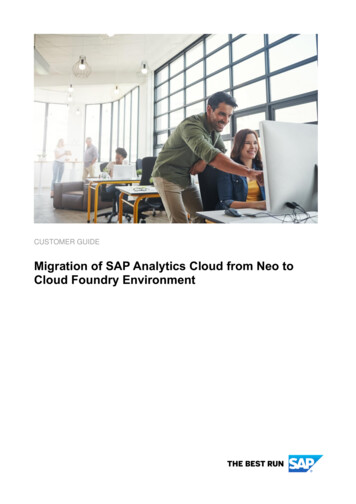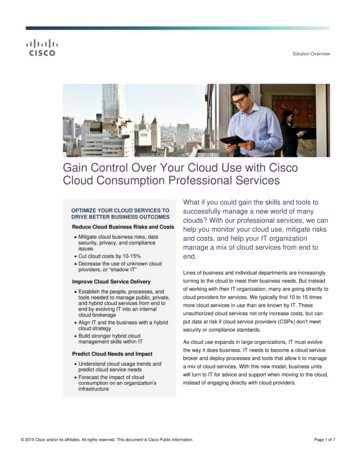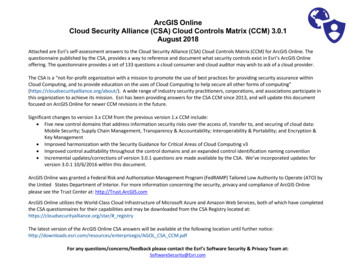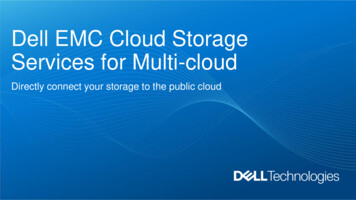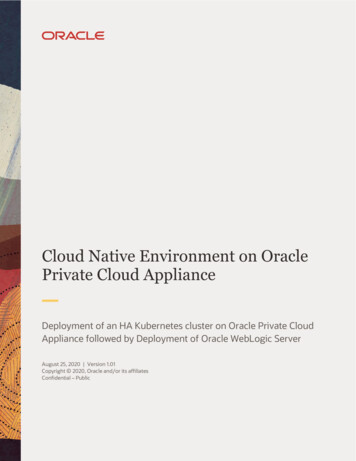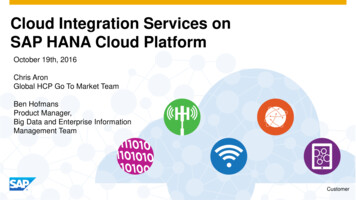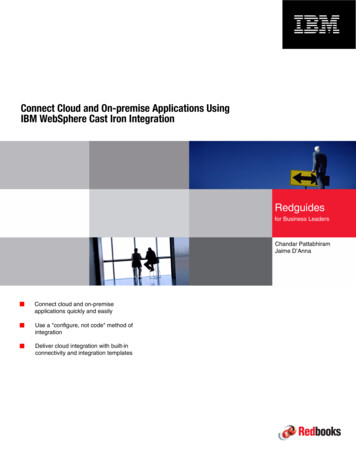
Transcription
Front coverConnect Cloud and On-premise Applications UsingIBM WebSphere Cast Iron IntegrationRedguidesfor Business LeadersChandar PattabhiramJaime D’AnnaConnect cloud and on-premiseapplications quickly and easilyUse a "configure, not code" method ofintegrationDeliver cloud integration with built-inconnectivity and integration templates
Executive overviewTo cut costs, drive productivity, and provide new capabilities quickly, companies are turning tocloud applications to meet their business needs. Cloud computing is a new consumption anddelivery model. This new style of computing provides applications, data, and IT resources tousers as services delivered over the network. In this case, the application is delivered as aservice known as software as a service (SaaS). Cloud applications can cut IT costs, byreducing the resources needed for cloud application deployment. These applications can alsoincrease the productivity of business users by making applications available at the time ofneed. Cloud applications (from service providers) have a pricing structure that reducesbudgetary issues, which can get in the way of procuring new applications.As the success of cloud applications grows, what were once department-level solutions toreduce cost and increase the effectiveness of specific employee teams now face hurdleswhen these solutions must grow to support the wider enterprise. On a daily basis, usersrequire access to various systems and applications that are critical to doing their job. Theseapplications can include cloud applications and on-premise systems and applications. It isvital that these applications and systems are integrated and function seamlessly, providingthe user with the latest information. Now many companies have a hybrid world of cloud andon-premise applications making integration critical.Known for industry-leading application-integration solutions, IBM has enhanced its solutionportfolio with the acquisition of Cast Iron Systems and its award-winning connectivityproduct IBM WebSphere Cast Iron Cloud integration. (This product was previously knownas Cast Iron OmniConnect.) With this new product, IBM can offer clients a completecloud-application-integration platform. Unlike traditional choices that offer multiple products oron-demand tools that provide rudimentary on-premise application integration capabilities,WebSphere Cast Iron Cloud integration provides a single robust solution. This solution isdesigned from the ground up to deliver everything needed for cloud and on-premiseapplication integration.This IBM Redguide publication provides information about WebSphere Cast Iron Cloudintegration, highlights its business value, and explains why it provides a complete solution tocloud and on-premise application integration. This guide is intended for executives, leaders,and architects who are looking for a quick and easy way to integrate cloud applications withtheir on-premise applications. Copyright IBM Corp. 2010, 2011. All rights reserved.1
Application integration: The Achilles’ heel of cloud computingCompanies that adopt cloud applications view application integration as the criticalcomponent to harmonize business processes across their hybrid application landscape. Withintegration, business users who use a cloud application can make the most of theirproductivity by having access to critical information that is unlocked from other systems andmade available in real time. By maximizing user productivity, a company can achieve the mosteconomic value of their investment.Scenarios of cloud integration include the following examples: Data migration from existing systems to new cloud applications A 360-degree view of customer information between cloud customer relationshipmanagement (CRM) and on-premise enterprise resource planning (ERP) applications Order, invoice and payment visibility from ERP to cloud CRM applications Recruiting and employee data integration between cloud human capital management andback-office applications Opportunity integration between cloud marketing automation, collaboration platforms ande-commerce applications Connection of private clouds with home-grown applications and business partner solutionsPrivate clouds: Private clouds are custom cloud applications that companies buildthemselves to meet their distinct needs. Such applications are typically built by usingtechnologies, such as web services and virtualization, that offer tremendous economiesof scale to large IT departments. You can compare these to public clouds, which areowned and managed by a service provider that delivers an agreed-to set of application,software, or infrastructure services on a pay-per-use basis.Because cloud applications offer similar benefits to all customers, any advantages gained atone company are just as easily available to its competitors. Cloud applications by themselvesprovide little differentiation unless they are integrated with a company’s back-end applicationsto streamline business processes that are core to their operations. Retaining thisdifferentiation and making the enormous quantity of corporate data available to the newer,more cost-effective cloud systems brings the issue of application integration to the forefront.Application integration has become the loyalty application for cloud providers. The moreintegrated they are with the rest of their customers’ enterprise applications, the more valuablethey are to their customers.Despite this critical need, application integration continues to be the Achilles’ heel for cloudadoption. Why has cloud application integration been so challenging? The answer lies in thefact that traditional choices have been incomplete.2Connect Cloud and On-premise Applications Using IBM WebSphere Cast Iron Integration
Traditional choices for cloud integrationTraditionally, companies have had the following choices for solving cloud integration problems: Use on-demand integration tools.On-demand integration tools have the required functionality to complete simplecloud-to-cloud integration scenarios. However, they lack the sophisticated capability that isrequired to integrate with customized on-premise applications and to harmonizeintegration processes across this hybrid application landscape. As a result, they havemainly been adopted by small companies that need low-cost integration options. Implement complex on-premise software platforms (traditional middleware solutions).The on-premise middleware platforms evolved to meet integration needs in largeenterprises. They provide sophisticated functionality to solve business processmanagement (BPM); extract, transform, and load (ETL); and Enterprise ApplicationIntegration (EAI) problems. But this rich functionality makes these platforms expensive toprocure, install, deploy and maintain for cloud integration projects. They often lackintegrated support for the specific cloud applications that companies might be adopting. Write custom code.Because the other options did not fit well, many companies have opted to develop customcode for integration. Although custom code provides an immediate fix at a seemingly lowercost, companies quickly realize that maintaining custom code is a labor-intensive andtime-consuming process. They also realize that the “hidden costs” go well beyond theinitial coding. Custom code also requires specialized skills that most IT organizations lackor cannot obtain easily. Finally, custom code requires up-front investments in time andresources that delay the benefits of using cloud applications.Solving integration problems with any of these traditional approaches produces results thatdiminish the benefits that are expected when companies choose cloud applications. Thesetraditional integration solutions substantially undermine the value of choosing cloudapplication and frustrate users who are expecting quick results. The poor fit betweentraditional integration approaches and the requirements of cloud computing has created theneed for a new type of integration platform.3
WebSphere Cast Iron Cloud integration: The complete solutionIn 2010, IBM acquired Cast Iron Systems, the leading SaaS and cloud application integrationprovider. Figure 1 shows WebSphere Cast Iron Cloud integration connecting with a samplingof various cloud application and on-premise application providers.Rapid – Flexible - uiteConcurBigMachinesCisco WebExWindows AzureSPS CommerceRightNowRainmakerAprimo AtTaskParatureGetThereAmazon.comSalary.com EloquaOracleHooversSpringCM nGeneraSuccessFactorsCRM OnDemandGearworksQuickArrowOneSource Salesforce.comRecruiting.comSAPBaanCSVfileGreat PlainsOracleQADJD EdwardsLawsonPeopleSoftIBM DB2EpicorSiebelSybaseXMLfile RemedyMicrosoft DynamicsMicrosoft SQL Server 2008FlatfileCA Clarity PPMFigure 1 WebSphere Cast Iron Cloud integration: The complete solutionBy using WebSphere Cast Iron Cloud integration, IBM clients can expect fast and flexibleSaaS and cloud application integration in the space of days. They can also achieve lower costand higher return on investment in cloud and SaaS models. Now IBM offers clients acomplete cloud application integration platform. Unlike the traditional choices, WebSphereCast Iron Cloud integration provides a single robust solution. This solution is designed fromthe ground up to deliver everything needed for cloud and on-premise application integration.WebSphere Cast Iron Cloud integration delivers the following sets of capabilities: Complete deployment flexibilityComplete cloud integration scenariosComplete connectivityComplete reusabilityEach set of capabilities is explained in the sections that follow.4Connect Cloud and On-premise Applications Using IBM WebSphere Cast Iron Integration
Complete deployment flexibilityWebSphere Cast Iron Cloud integration is a single product that offers the following formfactors for deployment:IBM WebSphere Cast Iron LiveA multitenant cloud serviceIBM WebSphere DataPower Cast Iron Appliance XH40A physical appliance built on market-leading IBM technology that canbe installed and managed within a local data centerIBM WebSphere Cast Iron Hypervisor EditionA virtual appliance that can be installed on a customer’s existingservers by using virtualization technologyAll three deployment options (illustrated in Figure 2) provide the same user experience fordeveloping and managing the integrations. Users have the unmatched flexibility of seamlesslytransitioning between these options. The advantage to cloud customers is the ability tochoose the right solution for their needs, rather than being limited by vendor offerings thatoften take a “one-size-fits-all approach.”WebSphere Cast Iron LiveMulti-tenant Cloud ServicePhysical IntegrationApplianceVirtual IntegrationApplianceFigure 2 The three deployment options for WebSphere Cast Iron Cloud integration5
Complete cIoud integration scenariosWebSphere Cast Iron Cloud integration provides the following three complete integrationproducts in one: Cloud data migrationBy using the WebSphere Cast Iron Cloud integration data handling, data cleansing anddata migration capabilities, companies accelerate and expedite the adoption of SaaS andcloud applications by their user communities. By using this approach to data integration,companies can cleanse, enrich and migrate data from existing applications to cloudapplications in real time. Cloud data synchronizationWebSphere Cast Iron Cloud integration provides connectivity, workflow andtransformation features, enabling the company to coordinate or orchestrate integrationprocesses across multiple applications in real time. Now, SaaS and cloud users canimmediately view data that is hidden in applications, minimize any duplicate entries andmaximize their own decision making and productivity. Cloud user interface (UI) mashupsOften information from disparate sources must be brought together and displayed withinthe native user interface of a single application. WebSphere Cast Iron Cloud integrationcan mash up that data to present a single unified view, without placing the data from oneapplication into another.Complete connectivityWebSphere Cast Iron Cloud integration comes with built-in connectivity to hundreds ofclouds, packaged and proprietary on-premise applications, including ERP, CRM, databases,web services and flat files. It is self-contained and includes everything needed to completeintegrations in one place. This progressive approach to integration makes no distinctionbetween local and remote applications because they establish connectivity to the end pointsby using native application protocols. The advantage is that no additional adapters arerequired, and there is nothing to install or change at the end points.Complete reusabilityWebSphere Cast Iron Cloud integration includes hundreds of reusable Template IntegrationProcesses (TIPs) that are searchable with a single click in an online library. This online librarycontains templates for all of the most common cloud integration scenarios. These templatesprovide a question-and-answer-based wizard that walks users through a common integrationscenario. For example, a TIP might request all the information needed to transform anopportunity in a CRM system to an order in an ERP system. Through this simplified interface,IBM customers and partners can create their own wizard-driven reusable templates with thepoint-and-click TIP Development Kit and make them instantly available to the entire Cast Ironuser community.6Connect Cloud and On-premise Applications Using IBM WebSphere Cast Iron Integration
Figure 3 shows an example TIP.1. Introduction2. SAP Connectivity CheckThis scenario extracts customer master data from SAP and creates corresponding Accounts in Salesforce.com.3. Salesforce.com Connectivity Check4. Extract SAP Customer5. Create Account in SFDCHTTP6. MAP Customer Data7. Define Validation Rules8. FinishedReceive RequestInvoke RFCStart DemoExtract customersIfTerminatePh # or City NullElseElseSAPTerminateCreate ObjectsCreate AccountSalesforceFigure 3 Example TIPHow this solution adds business valueWebSphere Cast Iron Cloud integration adds value to your business in various ways: Integration in daysThe Cast Iron TIP library enables companies to integrate in days, instead of weeks ormonths. This approach aligns with the deployment timelines of cloud applications andenables users to expedite their “go-live” timeframes. Significant cost savingsThe WebSphere Cast Iron Cloud integration “configuration, not coding” design has helpednumerous companies slash integration costs compared to traditional approaches. Inaddition, companies have reduced ERP licensing costs by eliminating the need for cloudusers to log in to back-office applications. Also because of the term licensing pricingoptions that are available, companies have slashed their up-front capital expenditurecosts. Enhanced IT innovationWebSphere Cast Iron Cloud integration is delivered through either an on-premiseappliance or the cloud with nothing else for IT to add or buy. Both approaches do notrequire complex coordination or specialized IT skills for deployment. Because of thesimplicity of the solution, IT executives can now reallocate senior resources to moreinnovation-oriented projects.7
Power of the ecosystemIBM is a strategic integration partner for many of the cloud providers in the world such asSalesforce.com, Google, Taleo, Oracle CRM, Cisco Webex, ADP and Success Factors. Asa result, IBM works with the respective product teams to be current on any API orfunctionality changes. Customers no longer have to spend months updating their customcoded integrations with any new API changes.Augmenting your existing enterprise service busWebSphere Cast Iron Cloud integration is built from the ground up for cloud integration. Itdoes not solve complex integration scenarios that are enabled by BPM, ETL and enterpriseservice bus (ESB) solutions. However, WebSphere Cast Iron Cloud integration is used toaugment such solutions with targeted cloud integration capabilities.For example, several large companies use ESBs as their integration backbone coupled withWebSphere Cast Iron Cloud integration to integrate specific cloud applications. Together theyenable a range of cloud and on-premise integration scenarios. In this context, the ESB can beconsidered as the enterprise integration highway, and WebSphere Cast Iron Cloud integrationcan be considered as the solution that integrates the cloud applications to the ESB.Example customer scenariosThis section provides two customer scenarios that demonstrate the use of WebSphere CastIron Cloud integration.Example 1: A large distributor of pharmaceutical productsA large pharmaceutical products distributor recently replaced various traditional systems withSalesforce.com as their CRM application for their call center service representatives (CSRs).The challenge was to empower all their CSRs with real-time information in Salesforce.com,enabling them to deliver a superior customer experience. This solution provides the CSRswith information about accounts payable and receivable, invoices, credit checks, order detailsand other data. This information existed in multiple back-office applications that had beenconsolidated by using a data warehouse. Historically, the CSRs spent hours collecting thisinformation by accessing multiple applications, which resulted in a significant loss of salesproductivity.The IT team’s main challenge was to reduce dependency on higher-cost resources forintegration projects and shift higher skills to more strategic or innovation initiatives.Traditionally the company relied on custom code to solve point-to-point integration problems,but found the approach to be non-scalable as their needs grew. The IT team conducted acomprehensive evaluation process and rejected proprietary on-premise ETL tools because ofthe coding complexity.8Connect Cloud and On-premise Applications Using IBM WebSphere Cast Iron Integration
The IT team deployed WebSphere Cast Iron Cloud integration to connect their SQL-basedhome-grown data warehouse with Salesforce.com in real time (Figure 4). This solution wasused to create a 360-degree view of customers in real time. Account, credit and salesinformation is now sent to Salesforce.com from the data warehouse. Orders and quotes thatare created in their e-commerce system are sent in real time to the data warehouse.SalesforceData Warehousee-Commerce SystemFigure 4 Example 1: Pharmaceutical products distributor solutionThe entire integration solution was delivered in just ten days. The company has reduced itsdevelopment resources resulting in an annual cost savings. In addition, the highly skilledresources are now assigned to innovation-oriented projects instead of integration projects. Byproviding this single view of customers in Salesforce.com, the company has significantlyimproved CSR productivity.Example 2: A large manufacturer of consumer devicesA large manufacturer of consumer devices has a wide range of cloud and on-premiseapplications including solutions from SAP, JD Edwards and various existing applications.They chose Salesforce.com as their CRM platform with the goal of delivering a superiorcustomer experience.Their diverse and disparate systems resulted in silos of information that forced their sales andtechnical service teams to access multiple systems for customer complaint data. They wantedto use Salesforce.com as the single application that provided a seamless, 360-degree view oftheir customers and maximized the productivity of their sales and technical service teams.9
After rejecting traditional integration methods, they chose WebSphere Cast Iron Cloudintegration (Figure 5) and its “configuration, not coding” approach for real-time, bidirectionalintegration. By using WebSphere Cast Iron Cloud integration, they performed integrationbetween Salesforce.com and the on-premise syst
Hoovers Salesforce.com GetThere NetSuite Concur Amazon.com RightNow SpringCM nGenera Parature QuickArrow Oracle CRM OnDemand Windows Azure SPS Commerce Baan QAD Microsoft SQL Server 2008 JD Edwards Oracle PeopleSoft Microsoft Dynamics SAP Siebel Great Plains Lawson IBM DB2 Sybase Remedy CA Clarity PPM Epicor Taleo Rapid – Flexible - Simple .
